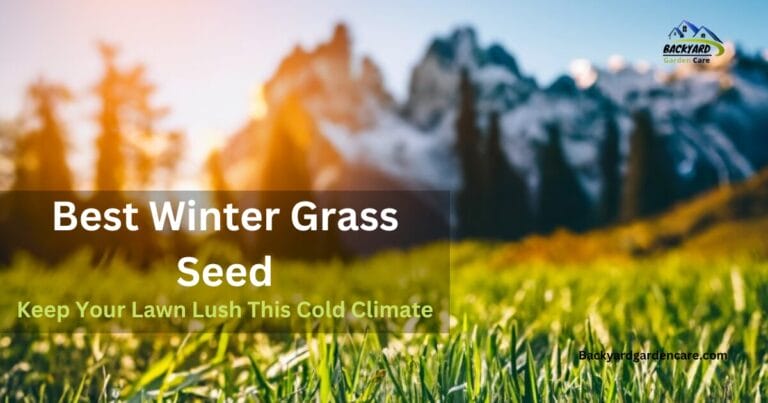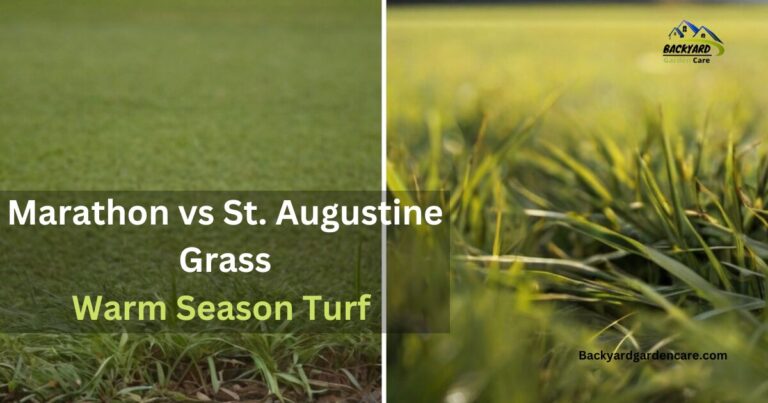When Does Grass Stop Growing? 3 Major Temperature Ranges Can Help You To Maintain a Healthy Lawn.
The grass is a critical element of outdoor landscapes, providing vibrant greenery and a natural carpet under our feet. But have you ever wondered about the growth habits of grass?
Understanding when the grass stops growing can be beneficial in managing and maintaining your lawn year-round. Various factors, such as climate and grass type, can influence the answer to this question.
In this article, we will look into everything you need to know about grass growth stopping. We’ll explore the factors that affect growth, and the different growth stages and provide tips on effectively managing your lawn throughout the year.

Let’s look at when does grass stop growing and uncover the secrets of grass growth.
Understanding the Key Factors of Grass Growth and Success.
The growth and success of grass, just like the growth and success of any other plant, depends on certain key elements. These elements include light, warmth, water for grass, air, and nutrients.
Without these essential components, the grass will cease to grow and enter a dormant state. During dormancy, the grass conserves energy and protects itself from extreme temperatures and harsh weather conditions.
Soil temperature plays a crucial role in the growth of grass. The heat present in the soil is influenced by various factors such as sunlight, solar radiation, cloud coverage, air temperature, grass coverage, land gradient, fertilizer, rainfall, nearby bodies of water, soil composition, and required lime for grass.
These factors collectively impact the overall temperature of the soil, which in turn affects the growth of grass. When temperatures drop, the microorganisms residing within the soil face difficulties in decomposing plants.
As a result, the soil releases less carbon dioxide, which directly impedes the photosynthesis process of grass. Furthermore, cold temperatures prevent grass from absorbing nutrients and water. This limitation prevents the roots from growing and developing during this period. Additionally, frost can also kill grass.
It is important to note that different plants have different preferred temperatures for optimal growth and development. Some plants thrive in warmer climates, while others are better adapted to more excellent environments.
Understanding these temperature preferences can be crucial for gardeners as it helps them select the right grass for specific regions and seasons. Furthermore, the impact of temperature on grass growth extends beyond the overall climate.
In fact, even slight temperature variations within a day can affect plant behaviour. For example, certain plants may respond differently to daytime and nighttime temperatures, affecting their growth patterns and cycles. Understanding the significance of maintaining optimal soil temperature for grass growth is important.
By ensuring that the soil temperature remains within the ideal range, you can provide the necessary conditions for grass to flourish. This can be achieved by implementing various strategies, such as selecting suitable grass varieties that are well-suited to the local climate and soil conditions.
How Much Temperature Does Grass Grow to?
The grass is a hardy plant that thrives in a wide range of temperatures. However, there are certain temperature thresholds that determine its growth and dormancy periods.
Understanding these temperature ranges can help you maintain a healthy and vibrant lawn throughout the year. This section will explore the temperature limits for grass growth and how different grass species respond to varying temperature conditions.
1. Warm-Season Grasses
Warm-season grasses are known for their ability to tolerate high temperatures. These grasses typically grow best when the temperature ranges between 80-95°F.
Some warm-season grass species, such as Zoysia grass and Bermuda grass, can even withstand temperatures ranging from 64-110°F. However, as the peak daytime temperature drops below 55°F, these grass varieties may start to slow down their growth.
2. Cool-Season Grasses
Unlike warm-season grasses, cool-season grasses prefer cooler temperatures for optimal growth. These grasses prosper in temperatures ranging from 50-65°F. However, they struggle to survive in temperatures above 85°F.
Cool-season grasses include popular species like Kentucky bluegrass, ryegrass, and fescue. While some winter grasses can withstand temperatures well below 50°F, the most common cool-season grasses have poor tolerance to freezing temperatures.
3. The Effects of Extreme Temperatures
When temperatures reach extreme ranges, grass undergoes changes that affect its growth and survival. The roots are particularly sensitive to temperature fluctuations in warm and cool grasses.
When temperatures become harsh, the roots can get damaged and ultimately stop growing. This triggers the grass to enter its dormant phase, a survival mechanism to protect itself from harsh conditions.
The grass depends on the warmth of the soil to sustain itself during the dormant phase. The grass blades may turn brown or lose their vibrancy, but the grass is still alive beneath the surface.
As the temperature becomes more favourable, the grass will gradually come out of dormancy and resume its growth cycle. To ensure healthy grass growth, it is essential to understand the temperature preferences of your specific grass species. By providing the right conditions, you can help your grass thrive year-round.
The Dormant Period: When the Grass Stops Growing
As the seasons change and winter begins, you may have noticed that your once lush green lawn starts to slow down and eventually stops growing altogether. This period of dormancy, when the grass goes into rest mode, is a natural and necessary part of its growth cycle.
Understanding this process can help you better care for your lawn and ensure its health and vitality all year round. So, what exactly is the dormant period? It is a phase when the grass slows down its metabolic activities and conserves energy to survive harsh weather conditions.
During this time, the growth rate decreases significantly, and the grass blades may lose their vibrant green colour, turning brown or straw-like. While it may seem like your lawn is dying, it is actually just taking a break and preparing for the next growing season.

The dormant period typically occurs in regions with cold winters, where temperatures drop below freezing. However, It is important to remember that even in milder climates, grass can experience a period of dormancy during dry spells or extended periods of extreme heat.
This is the grass’s way of protecting itself from unfavourable conditions and ensuring its long-term survival. During this resting phase, there are a few important things to keep in mind to maintain the health of your lawn.
First and foremost, watering requirements are reduced. Since the grass is not actively growing, it only needs as much water as it does during the growing season. However, it is still essential to provide some moisture to prevent the roots from drying out completely.
Aim for deep, infrequent watering to reach the deeper soil layers where the roots are located.
Mowing frequency should also be adjusted during the dormant period. As the grass is not actively growing, you can reduce the frequency of mowing or even stop altogether.
However, keeping the lawn at a manageable height is important to prevent it from becoming a haven for pests and diseases. Aim to maintain a height of around 2-3 inches during this time.
Weeds can also take advantage of the grass’s dormant state, so watching for any unwanted invaders is important. Applying herbicides during this time isn’t recommended, but hand-pulling weeds or spot-treating them can help prevent them from spreading.
While fertilization is essential for promoting grass growth, avoiding fertilizing during the dormant period is best. Applying fertilizer can stimulate new growth, which is vulnerable to winter damage.
Since the grass is not actively growing, it is more susceptible to damage. Minimize walking or playing on the lawn to prevent compaction or stress on the dormant grass. Lastly, be patient and allow nature to take its course.

The dormant period is a natural part of the grass’s life cycle, and it will eventually come to an end. As the temperatures start to rise and the days get longer, the grass will gradually break out of its dormancy and resume its regular growth pattern. With proper care and maintenance, your lawn will return to its vibrant green state quickly.
When Temperatures Are Extreme, How Long Will Grass Stay Dormant?
As a home lawn owner and a professional gardener my opinion is, that grass tends to stay dormant for quite a while when temperatures reach extremes. During brutally cold winters in my region, I’ve observed my lawn remaining dormant for several months, with snow acting as a protective insulator against the freezing cold. However, it’s essential to consider another perspective.
A friend of mine, who resides in a milder climate, shared a different viewpoint. In their experience, grass tended to remain dormant for shorter durations during extreme temperatures. Without the insulation of snow, it typically stayed dormant for a few weeks rather than months.
These varying experiences highlight the influence of climate and local conditions on the duration of grass dormancy during extreme temperature fluctuations.
Summer Dormancy
During the hot summer months, when water becomes scarce, grass can enter a state of dormancy to conserve energy and water. This dormancy allows the grass to survive the dry and harsh conditions until favourable conditions return.
The length of time grass can remain dormant during summer drought varies depending on the grass species and its resilience. Generally, most grasses can endure up to a month of dormancy during a severe drought. However, it’s important to note that this tolerance can vary greatly.
A few grasses can survive the absence of water for longer periods, while others are more likely to struggle with even a short water shortage. Moreover, the health and strength of the grass also play a significant role in its ability to sustain dormancy.
Winter Dormancy
Unlike summer drought dormancy, grass has an easier time coping with winter dormancy, thanks to the protection offered by snow blankets. When temperatures drop and the ground freezes, grass enters a dormant state to shield itself from the cold and conserve energy.
Underneath a layer of snow, lawns can remain dormant for an extended period, sometimes lasting for several months. The snow acts as an insulating blanket, providing a protective barrier against freezing temperatures. Does straw is a good option for protecting grass seeds?
This protective layer helps to maintain a more stable temperature for the grass beneath, reducing the risk of frost damage. Consequently, winter dormancy is generally less challenging for grass than summer dormancy.
In short, Grass can remarkably enter a dormant state during temperature extremes, allowing it to survive harsh conditions.
While the duration of dormancy varies depending on the grass species and its health, most grasses can withstand up to a month of summer drought dormancy and several months of winter dormancy under a protective snow blanket.
Is It Better to Leave Your Lawn Long or Short for Winter?
When preparing your lawn for winter, there is often the debate of whether it’s better to leave it long or cut it short. While there are different points of thought on this matter, mowing your lawn short before winter arrives is generally recommended.
The ideal height to aim for is around 2 to 3 inches. By mowing your lawn shorter before winter, you are allowing the grass to continue photosynthesizing and gathering nutrients before it gets covered with snow.
This is important because it helps keep the grass healthy and strong during cold winter. If you were to leave the lawn long, the snowfall could cause the frost to cling to the blades, potentially causing damage to the grass.
Final Thoughts
understanding the factors that affect the growth of grass can help determine when it stops growing. Grass growth is influenced by various factors such as temperature, sunlight, moisture, and nutrients.
As the temperature drops below a certain threshold, grass growth slows down and eventually stops. Similarly, grass may enter a dormant state during extreme heat or drought periods and stop growing.
It is important to remember that different grass species have varying growth patterns and may exhibit different growth rates. Overall, keeping optimal conditions and providing proper care will make your grass grow healthy.
FAQs
When Does Grass Stop Growing in Ohio?
Grass in Ohio typically stops growing in the late fall or early winter. However, the exact timeframe can vary depending on weather conditions and the specific type of grass.
As temperatures drop and daylight hours decrease, the grass enters a dormancy period.
During this time, growth becomes minimal or ceases altogether until the following spring.
When Does Grass Stop Growing in Georgia?
Grass in Georgia typically stops growing during the winter months when temperatures drop below freezing. However, the exact timing can vary depending on the specific region of Georgia and the specific type of grass.
What Temperature Does Grass Go Dormant?
Grass typically goes dormant when temperatures drop below 50 degrees Fahrenheit (10 degrees Celsius). During dormancy, g Grass slows down its growth and metabolic processes to conserve energy and withstand harsh weather conditions.
It may appear brown or yellowish during this period, but it is not dead. Once temperatures rise again, usually in spring, the grass resumes normal growth and regains its green colour.
Does Grass Eventually Stop Growing?
Grass does not eventually stop growing. It has a natural life cycle that includes periods of growth and dormancy. During the growing season, grass grows, producing new blades and roots.
However, when environmental conditions become less favourable, such as during the winter or drought, grass enters a dormant state where growth slows down or stops temporarily.
Once conditions improve, grass will resume its growth cycle. So, while grass may experience slower growth or dormancy periods, it does not permanently stop growing.
When Should I Stop Cutting My Grass?
The frequency of cutting your grass depends on various factors, such as the grass type, weather conditions, and personal preferences.
However, a general rule is to stop cutting your grass when it has stopped growing for the season. Depending on your location, this typically occurs in late fall or early winter.
Jack Ralph

hey, I’m Jack Ralph, a dedicated grass and lawn expert with years of experience creating beautiful outdoor spaces. I can help you achieve the lawn of your dreams, from seeding to mowing, turning your yard into a natural masterpiece.
Look no further—I’m the key to transforming your lawn dreams into reality! and here to help you achieve a lawn that’s not just a patch of grass, but a canvas of natural artistry.







